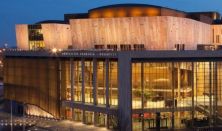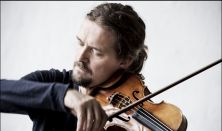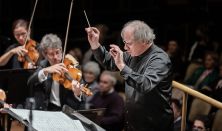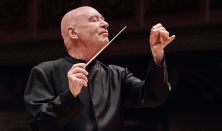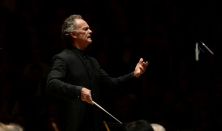 Buy tickets
Buy tickets
Search: Müpa
Taking the stage together with one of the world’s most celebrated orchestras at this concert will be two illustrious sons of musical families: Paavo Järvi, who hails from a family of conductors, and Alexandre Kantorow, a pianist born to violinist parents.
A magyar-ghánai Sena Dagadu a 21. századi hazai popzene jelentős alakja, akinek az Irie Maffia zenekar és szólóprodukciói mellett meditatívabb, Sena DagaDub nevű triója is igen népszerű. A formáció 2024-ben a magyar zenei élet élő legendáját, Presser Gábort látta vendégül a Müpában, és az együttműködés annyira jól sikerült, hogy a projekt most mindkét fél – és persze a közönség – örömére folytatódik.
Van-e ott haza még… - Irodalmi összeállítás harmonikakísérettel / LITERÁRIUM EXTRA Szép
Budapest, MüpaOne thing we know for certain about the 21st century is that it will be when the survivors of the Holocaust take their last breath. Every single one of them. Slowly but surely, they are leaving us to our own devices. “Do we want to forget what happened, as if it were a bad dream, or do we want to accept the events as human civilization’s greatest trauma?” the author Péter Esterházy once asked.
Born into a musical family and soon revealing herself to be a child prodigy, Varijashree Venugopal pioneered the way in integrating her own musical roots, India’s classical Carnatic tradition, into the medium of jazz.
When we think about words being used to create art, that can mean two things: literature and song lyrics.
The 12 Cellists of the Berlin Philharmonic are a unique ensemble, composed exclusively of instrumentalists from the cello section of one of the world’s top symphony orchestras.
A Németh László-ügyirat - Zenés-irodalmi előadás / LITERÁRIUM – Kortárs írók a Müpában Szép
Budapest, MüpaBorn 125 years ago, László Németh rightly deserves a place on any list of the most significant authors of 20th-century Hungarian literature. This programme aims not only to commemorate the writer’s diverse oeuvre, but also to encourage the audience to reread and rediscover it by recalling passages, both familiar and lesser-known, selected from different eras of his career.
Every year since 2008, this festive gala of Hungarian folk and world music has filled Müpa Budapest to bursting. On this occasion, the evening will be framed by the Moldavian and Gyimes dance house music of Róbert Kerényi and the Szigony Band, while the still-youthful musicians of the Sarjú Band are also experienced dance house performers.
First came the microgroove, then the LP, originally in the form of what we now call the vinyl album. Usually 12 inches in diameter and playing at a speed of 33 1/3 rotations per minute, it could accommodate up to 50 minutes of music, making it a respectable medium for even a complete rock opera.
Szüts Apor – zongora Budafoki Dohnányi Zenekar Vezényel: Hollerung Gábor
A band committed to modernising Indian classical music, Araj consists of five young musicians considered in their homeland to be the outstanding performers of their generation. Formed by tabla player Ishaan Ghosh, all members are virtuosos of their instruments (tabla, sitar, bamboo flute, sarangi) and vocal techniques, and their interplay breathes new life into the Indian classical tradition.
BACH / BEETHOVEN / STRAVINSKY // Tetzlaff / Keller J. S. BACH: Contrapunctus XIX (A fúga művészetéből, Luciano Berio feldolgozásában) BEETHOVEN : D-dúr hegedűverseny, op. 61 J. S. BACH: Két prelúdium és fúga a Das Wohltemperierte Klavierből (Stravinsky feldolgozásában) STRAVINSKY: Tavaszi áldozat
BACH / MESSIAEN / LIGETI / BEETHOVEN // Kodály Kórus / Keller J. S. BACH: Ricercar a 6 (A Musikalischen Opferből, Webern feldolgozásában) MESSIAEN: Les Offrandes oubliées LIGETI: Lux Aeterna BEETHOVEN: 9. szimfónia, op. 125
BARTÓK FUNDAMENTUM - Christoph Eschenbach MŰSOR Bartók: I. hegedűrapszódia, BB 94b Bartók: II. zongoraverseny, BB 101 Bartók: Concerto zenekarra, BB 123 KÖZREMŰKÖDIK Kelemen Gáspár - hegedű Tzimon Barto - zongora VEZÉNYEL Christoph Eschenbach
Baz Luhrmann: Moulin Rouge (2001) - Music Till Death Do Us Part / MÜPA FILM CLUB Szép
Budapest, MüpaIn the original language, with Hungarian subtitles. The discussions before and after the screening will be conducted in Hungarian.
Vincenzo Bellini’s final opera is a veritable apotheosis of bel canto that should only be presented to an audience with performers displaying impeccable technique and stylistic sensibilities.
Vincenzo Bellini’s final opera is a veritable apotheosis of bel canto that should only be presented to an audience with performers displaying impeccable technique and stylistic sensibilities.
In the original language, with Hungarian subtitles. The discussions before and after the screening will be conducted in Hungarian.
A Kossuth-díjas Vujicsics együttes alapítótagja, a hetvenéves Borbély Mihály pályafutása során mindig azon dolgozott, hogy bemutassa a hangfolyamok útját azok forrása és deltavidéke között.
Known for her sensitive interpretation of roles, the Finnish soprano Camilla Nylund will once again demonstrate in this evening of lieder what an outstanding performer of the German repertoire she is.
The globally beloved Portuguese genre of fado is already familiar to the Müpa audience, and now one of its greatest contemporary stars is visiting Budapest for the first time. Nominated for a Latin Grammy, Carminho is a true heir to her mother, Teresa Siqueira, and was celebrated as the genre’s great hope in 2005, even before she reached the age of 20.
Together with her internationally successful early music ensemble, L’Arpeggiata, harpist and theorbo-player Christina Pluhar are renowned for fashioning each and every concert programme out of a unique project. For this occasion, they have chosen one of the greatest masterpieces from the Baroque opera literature:
Born in Vilnius and with Armenian roots, the soprano Asmik Grigorian is one of the biggest favourites – and no longer an outside favourite – on today’s international opera scene.
Concert-format opera performance in three acts, with one intermission, in Russian
“Mihály Csokonai Vitéz’s most famous portrait shows a man in a Hungarian fur-lined mantle gazing at us with large, open eyes. Whoever etched this image into copper never set eyes on the poet, " writes László Bertók.
Daniel Harding and the Orchestra of the Accademia Nazionale di Santa Cecilia, Rome Szép
Budapest, MüpaThis concerto has all the attributes to make it a genuine celebration for the audience.
DEBUSSY, SAINT-SAËNS - JEAN-CLAUDE CASADESUS Kocsis/3 Szép
Budapest, Hungarian National PhilharmonicA French evening in the spirit of refinement, colours, moods – and pathos. The Debussy work, L’Après-midi d’un Faune, heralds the birth of impressionism and the two Saint-Saëns compositions, the Cello Concerto in A minor and the hugely popular Organ Symphony, represent romanticism – the latter of which is heavily influenced by Liszt. It is not just the composers who are French: so are the conductor and the soloist.
Warning! The basket time limit is about to expire!
item(s) in basket
total:
Time limit has expired. Please, put item(s) in to basket again.







